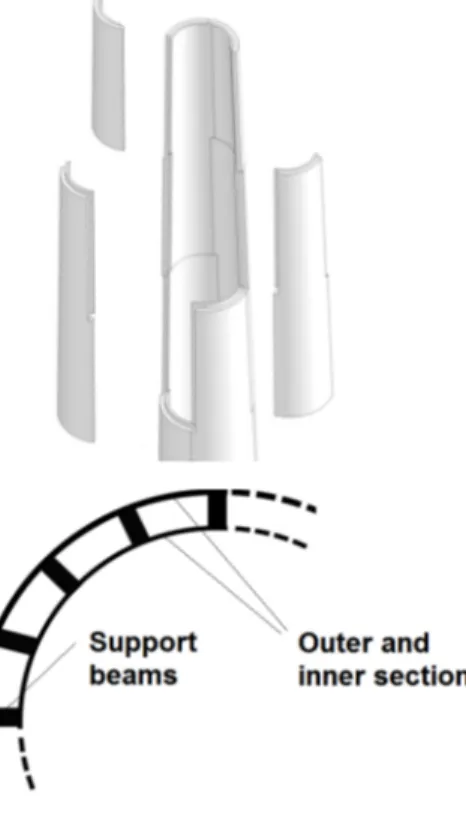ISBN: 978-91-88898-64-7
27
Structural design methods for tall timber towers with large wind turbine
Petra Steen‡, Pierre Landel*, Erik Dölerud† and Otto Lundman†I ‡petra.steen@gmail.com
*Research Institutes of Sweden, pierre.landel@ri.se
†Modvion, erik@modvion.com, otto@modvion.com
As wind power towers grows taller and wider, transportation issues of large parts to the site have appeared due to restriction on the roads. The company Modvion developed a modular design of wind power towers made of wood products and their concept provides advantages concerning transportation and assembly. Such a concept makes it possible to build tall towers with lower costs and reduced CO2 emission [1]. But technically, the challenges for tall timber towers are multiple and the durable resistance to strong winds must be carefully studied during the design state of the product. In [2], three different analytical methods have been implemented and compared to evaluate the loads effects on the wood structure for ultimate limit states. Description of the methods and the main outcomes are presented in this abstract.
The objective was to carry out a strength and functional analysis to verify the structural design of a 120 m tower in ultimate limit state. The work included: 1. an analytical model based on Euler Bernoulli beam theory, 2. a finite element model with shell elements and static loads and 3. a dynamic model including wind simulation in the time domain and interference from a 5 MW turbine installed at the top of the tower. The loads and the material strength verifications were applied according to the Eurocodes. The dynamic analysis was performed to verify that the turbine rotor speed is not operating in or close to the towers’ first natural frequency and finally an elementary check of the risk from vortex shedding was studied. The structure of the tower was made of several timber modules with conical shape. The wall consisted of an outer and an inner panel made of LVL panels connected with glulam beams. A conceptual sketch of the modular system and the cross section is shown in
Figure 1. The analytical beam model was implemented on MATLAB, the FE-model was developed with ANSYS and the dynamic analysis was done using FAST. The wind profile for the dynamic analysis was generated with TurbSim, which is a stochastic turbulent wind simulator, with characteristic mean wind speed of 12 m/s and turbulence factors according to the IEC standard for wind turbine.
The developed analytical beam model shows to be a useful and straight forward tool for an initial structural design of the tower. The results correspond well with the advanced FE-model. The dynamic model implemented with the FAST tools shows that the analytically determined loads are conservatively estimated. Comparable thrust is 25 % and 9 % smaller in the turbulent and uniform wind field respectively. The analytically calculated torque is closer to results from the dynamic analysis, which shows a 6 % difference in the turbulent and uniform condition. Thus, the simulation in the uniform wind field yields a more similar result to the analytical calculation than the turbulent wind field simulation. Moreover, the towers’ structural materials and dimensions are fulfilling several requirements for strength resistance and functionality at ultimate limit state. Finally, the results imply that the different analytical methods can be implemented to design taller timber towers for greener and cheaper wind power production. However, there are still more conditional effects and scenarios that must be studied and analyzed in detail. Among others, the shear strength in the timber wall modules should be investigated and the fatigue strength of the connections is critical matter [3]. Fatigue strength of timber connections is not well known and will be tackled through series of cyclic tests.
References
[1] A. Angantyr and D. Hägerby (2011). Trätorn – Kan det vara något för svensk vindkraft i skogsmiljö? Projekt Energi- och miljökompetenscentrum, rapport 2011:1
[2] P. Steen (2017). Structural Design of a Wooden Wind Tower Structure. Master’s Thesis, Chalmers University of Technology, Gothenburg, Sweden
[3] Z. Christian and S. Aicher (2016). Fatigue behaviour of timber composites and connections for ultra high wooden towers. In 2016 World Conference on Timber Engineering, August 22-25, Vienna, Austria.
Figure 1: The modular design and the conceptual cross-section of the tower
